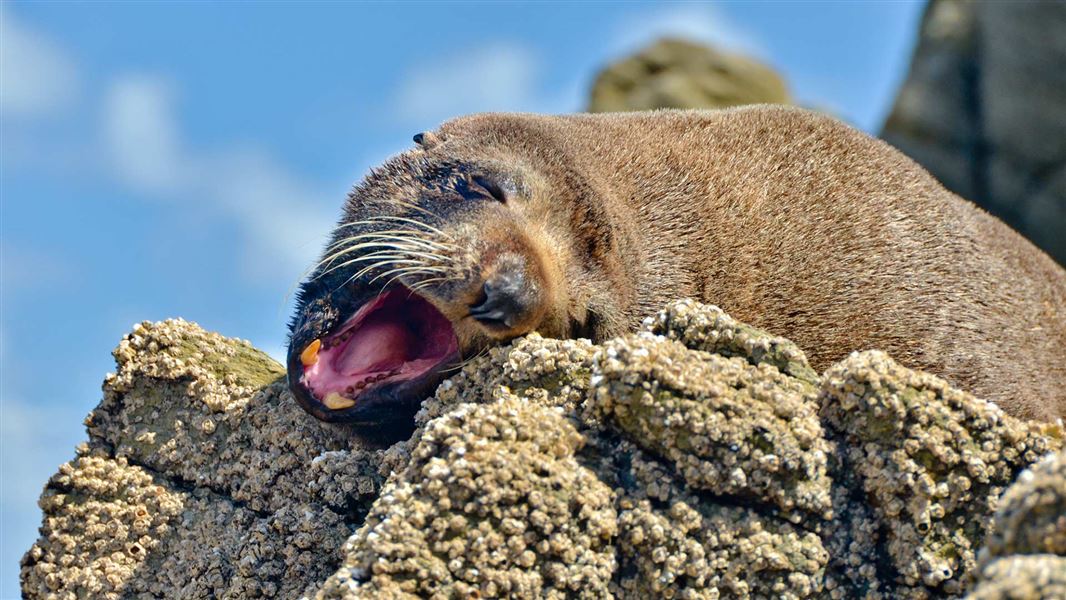Once at the brink of extinction
Before the arrival of humans, a population of about 2 million fur seal/kekeno inhabited New Zealand. They were taken as food by Māori, and the onset of European sealing for meat and pelts in the 1700s and 1800s pushed them to the brink of extinction.
On the way to recovery
In 1978 fur seal/kekeno were fully protected by the Marine Mammals Protection Act, and they have continued to grow in numbers ever since. Research in Otago has shown a population increase of 25% per year between 1982 and 1994. Surveys in 1995 indicated this was continuing.
A similar rate of increase has been noted in the Nelson/Marlborough region and also in the subantarctic Bounty Islands, and along Banks Peninsula and the Kaikoura coast. Since 1991, fur seals have recommenced breeding on the North Island. In Australia population increases may range from 16 to 19% per year.
Although there are no estimates of population growth available for Southland, a nationwide survey in the 1970s showed fur seals in Southland accounted for over 40% of the total New Zealand population or 70% if the subantarctic islands are included.
Although fur seals/kekeno are recovering in most of the country, a decline in some colonies on the West Coast of the South Island has been a focus of monitoring for some time. One of the possible reasons for this is the ongoing accidental capture of mature females in the winter fishery for spawning hoki.
Human impacts
Human activities are the cause of most threats to kekeno today. It is known that fur seals are incidentally captured and subsequently drown during trawling and long line fishing operations in New Zealand. The West Coast hoki trawl fishery’s impact on fur seals is the most well understood and considerable effort has been made to reduce fishing impacts in that fishery.
Other human impacts on seals include tourism, entanglement in marine debris, deliberate harassment, dogs, and oil and gas exploration and oil spills.
The ability to see seals in their natural environment is a very important component of New Zealand’s tourism industry. However, too much or very close attention can have a negative impact on seals’ abilities to rest, and a mother’s ability to look after her pup adequately. What to do if you find a seal.
Marine debris, or rubbish that winds up in the sea, such as plastics and discarded nets, can be lethal to seals. If you see plastic rubbish (especially in the shape of a ring – or seal sized necklace) pick it up and put it in the rubbish. See Seal callouts in the Kaikoura region involving DOC (PDF, 352K).
Sadly there have been cases where people have deliberately harmed seals or dogs have attacked fur seal pups. Always keep dogs under control and put them on a leash when wildlife is present.
Oil and gas exploration can have an impact on all marine life, seals included. It is unclear the effects that excessive noise from exploration can have on seals. DOC is actively working with industry to minimise the impacts to marine mammals through a voluntary code of conduct for seismic survey operations developed in 2012.
Oil spills like the MV RENA can also have an impact on fur seals if they get too much oil covering their fur. If there are seals in the area of an oil spill it can be difficult to tell if they actually need help. If they are grooming their fur excessively, or their movement appears uncoordinated then they will need to be cleaned. However, in a light spill most seals will be able to avoid the slicks and keep out of harms way.
Non-human impacts
Great white and sevengill sharks are the main natural predators of seals. New Zealand sea lions may occasionally take juvenile fur seals in locations where these two species overlap.
Killer whales (orcas) and leopard seals may also prey on kekeno.
